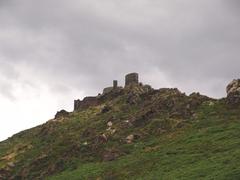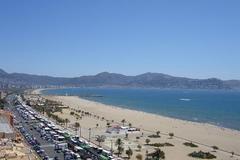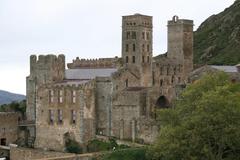Rhode Roses, Spain: Visiting Hours, Tickets, and Historical Sites Guide
Date: 14/06/2025
Introduction to Rhode (Roses), Spain – What to Expect
Located on the scenic Costa Brava in northeastern Spain, Roses—known in antiquity as Rhode—offers a captivating blend of history, coastal beauty, and vibrant Catalan culture. Established as one of the earliest Greek colonies in the western Mediterranean around the 5th century BCE, Roses has evolved through Greek, Roman, Visigothic, medieval, and Renaissance eras. The town is a treasure trove for history enthusiasts, with landmark sites like the Ciutadella de Roses, an extensive fortress revealing centuries of layered heritage, and the Castell de la Trinitat, a Renaissance-era bastion with commanding views of the bay.
Beyond its historical allure, Roses is celebrated for its stunning beaches, secluded coves, and proximity to renowned natural reserves such as the Cap de Creus Natural Park and Aiguamolls de l’Empordà. The town also boasts a rich maritime and culinary tradition, featuring fresh seafood and acclaimed Empordà wines. This comprehensive guide explores the key historical sites, practical visitor information, ticketing, accessibility, and travel tips to help you plan an unforgettable visit. For official updates and detailed planning resources, refer to the official Roses tourism site, Greek Reporter, Costa Brava Lifestyle, and Spain.info.
Table of Contents
- Introduction
- History of Roses (Rhode)
- Key Historical Sites & Visiting Information
- Natural Attractions & Outdoor Activities
- Gastronomy & Local Products
- Practical Visitor Tips
- Frequently Asked Questions (FAQ)
- Conclusion & Travel Resources
History of Roses (Rhode)
Greek Origins
Roses began as the Greek colony of Rhode, likely founded in the 5th century BCE by settlers from Massalia (modern Marseille), with possible connections to the island of Rhodes. Its strategic position on the Gulf of Roses fostered flourishing trade and cultural exchange. Remarkably, Rhode was among the first western Greek colonies to mint silver drachmai, signaling its economic importance (Greek Reporter). Today, remnants of this era are visible in the Ciutadella de Roses.
Roman and Visigothic Periods
The Romans took control in the 2nd century BCE, integrating Roses into Hispania. They left behind significant structures, including a paleochristian church and necropolis, reflecting Roses’ role as an early Christian hub (Wikipedia). The Visigothic influence is evident in fortified settlements such as Puig Rom Castrum, which can be visited today.
Medieval Development
Roses flourished in the Middle Ages, anchored by the Benedictine monastery of Santa Maria de Roses (first cited in 944 CE). The town developed economic autonomy after joining the Crown of Aragon in 1402. Medieval fortifications and remnants of the old town are preserved within the Ciutadella (Wikipedia).
Renaissance Fortifications
The 16th century saw Roses threatened by North African pirates and Ottoman fleets. Emperor Charles V ordered the construction of the pentagonal Ciutadella de Roses in 1543, completed under Philip II in 1553. The Castell de la Trinitat, constructed on a headland, was instrumental during the Napoleonic sieges (Costa Brava Lifestyle).
Key Historical Sites & Visiting Information
Ciutadella de Roses
- Hours: Generally open 10:00–19:00 in summer (April–October), 10:00–17:00 in winter (November–March). Confirm exact times on the official site.
- Tickets: €6 adults, €3 seniors/students, children under 12 free. Guided tours available for an extra fee.
- Highlights: Greek and Roman remains, medieval walls, Renaissance fortifications, and the Santa Maria monastery.
- Accessibility: Partially wheelchair accessible with ramps and assistance available.
Castell de la Trinitat
- Hours: 10:00–17:00, closed Mondays. Summer hours may be extended.
- Tickets: Around €3. Combined tickets with the Ciutadella sometimes offered.
- Features: Panoramic bay views, exhibits on military history, excellent photography spots.
Other Archaeological Sites
- Puig Rom Visigothic Castrum: Accessible via hiking trails just outside Roses.
- Dolmen de la Creu d’en Cobertella: Prehistoric megalithic site on the Megalithic Route.
- Empúries: Major Greek/Roman site 20 km south of Roses, open daily, €6 entry.
Natural Attractions & Outdoor Activities
Beaches & Coves
Roses boasts over 1.5 kilometers of golden-sand beaches, such as Platja de Roses, ideal for families. Secluded coves like Cala Montjoi, Cala Jóncols, and Cala Murtra offer tranquility and excellent snorkeling (Spainist). Beaches are generally free to access, with seasonal lifeguards and accessible facilities (Costa Brava Lifestyle).
Natural Parks
- Cap de Creus Natural Park: A dramatic landscape of cliffs and unique geology, open year-round. Visitor centers operate 9:00–18:00 in summer (Travel Inspires).
- Aiguamolls de l’Empordà: Wetland reserve west of Roses, home to 300+ bird species. Visitor center open 10:00–18:00. Birdwatching is best in spring and autumn (Travel Inspires).
Hiking, Cycling, & Water Sports
- Hiking: Trails along the GR-92, Cap de Creus paths, and Puig de l’Àliga offer Mediterranean views and megalithic monuments.
- Cycling & Horseback Riding: Varied routes for all levels; local rentals and guided tours available (Spainist).
- Water Sports: Sailing, kayaking, paddleboarding, diving, and boat trips are popular, especially from April to October (GetYourGuide).
Gastronomy & Local Products
Mediterranean Culinary Heritage
Roses is renowned for the Mediterranean diet, emphasizing fresh seafood, local produce, and Empordà wines (LazyPedals). The town’s fishermen’s port hosts daily auctions of prawns, monkfish, and anchovies (Visit Roses - Shopping). Traditional markets provide cheeses, wines, olive oils, and Catalan sweets.
Signature Dishes
- Suquet de Peix: Traditional fish stew.
- Arroz de Marisco: Seafood rice.
- Grilled Prawns/Anchovies: Prepared simply to highlight freshness.
Local dining options range from casual bistros to renowned restaurants like the former El Bulli. The Empordà region offers wine tours and tastings (Travelling Buzz).
Practical Visitor Tips
- Getting There: Closest airports are Girona-Costa Brava (70 km) and Barcelona-El Prat (170 km). Buses and trains connect via Figueres.
- Getting Around: The town is walkable. For exploring the region, car or bike rental is recommended.
- When to Visit: Late spring (May–June) and early autumn (September–October) offer the best weather and fewer crowds.
- Accessibility: Most major sites and beaches offer accessible facilities; some historic locations have uneven terrain.
- Tickets: Buy on-site or online; book guided tours in advance during high season.
- Local Services: ATMs, pharmacies, and medical assistance are available in town; emergency number is 112.
Frequently Asked Questions (FAQ)
Q: What are the Ciutadella de Roses visiting hours?
A: Typically 10:00–19:00 in summer, 10:00–17:00 in winter. Check the official website for updates.
Q: Are tickets needed for the Ciutadella and Castell de la Trinitat?
A: Yes, with discounts for seniors, students, and children. Combined tickets are sometimes available.
Q: Is Roses suitable for people with reduced mobility?
A: Many sites and beaches are accessible; some historic areas may have uneven ground.
Q: Are guided tours available?
A: Yes, for major sites and outdoor activities. Book in advance, especially in summer.
Q: What is the best time to visit for outdoor activities and birdwatching?
A: Late spring and early autumn offer ideal conditions and excellent birdwatching opportunities.
Conclusion & Travel Resources
Roses is a destination where ancient history, scenic landscapes, and Catalan gastronomy come together. From the archaeological wonders of the Ciutadella and megalithic sites to the pristine natural parks and sun-drenched beaches, there is something for every traveler. Plan ahead by checking opening hours, accessibility, and ticketing options to ensure a smooth visit.
For more information and updates, download the Audiala app, visit the Ciutadella de Roses website, and consult the Costa Brava Tourism Board. Explore further with Spain.info and The Crazy Tourist.
Additional Travel Planning Resources
- Ciutadella de Roses Official Ticketing
- Costa Brava Tourism Board
- Greek Colonies in Spain – Greek Reporter
- Spainist – Roses, Costa Brava
- Travel Inspires – Things to Do in Roses
- LazyPedals – Gastronomy in Empordà
- Travelling Buzz – Top Things to Do in Roses
- The Crazy Tourist – Best of Costa Brava
- Rose Directory – Cultural Significance
Visuals & Interactive Tools
- Explore interactive maps and virtual tours of Roses’ historical sites on the official tourism website.
- Images: ‘Ciutadella de Roses historical site entrance’, ‘Castell de la Trinitat panoramic bay view’, and ‘Cap de Creus Natural Park hiking’ available on official and partner sites.



